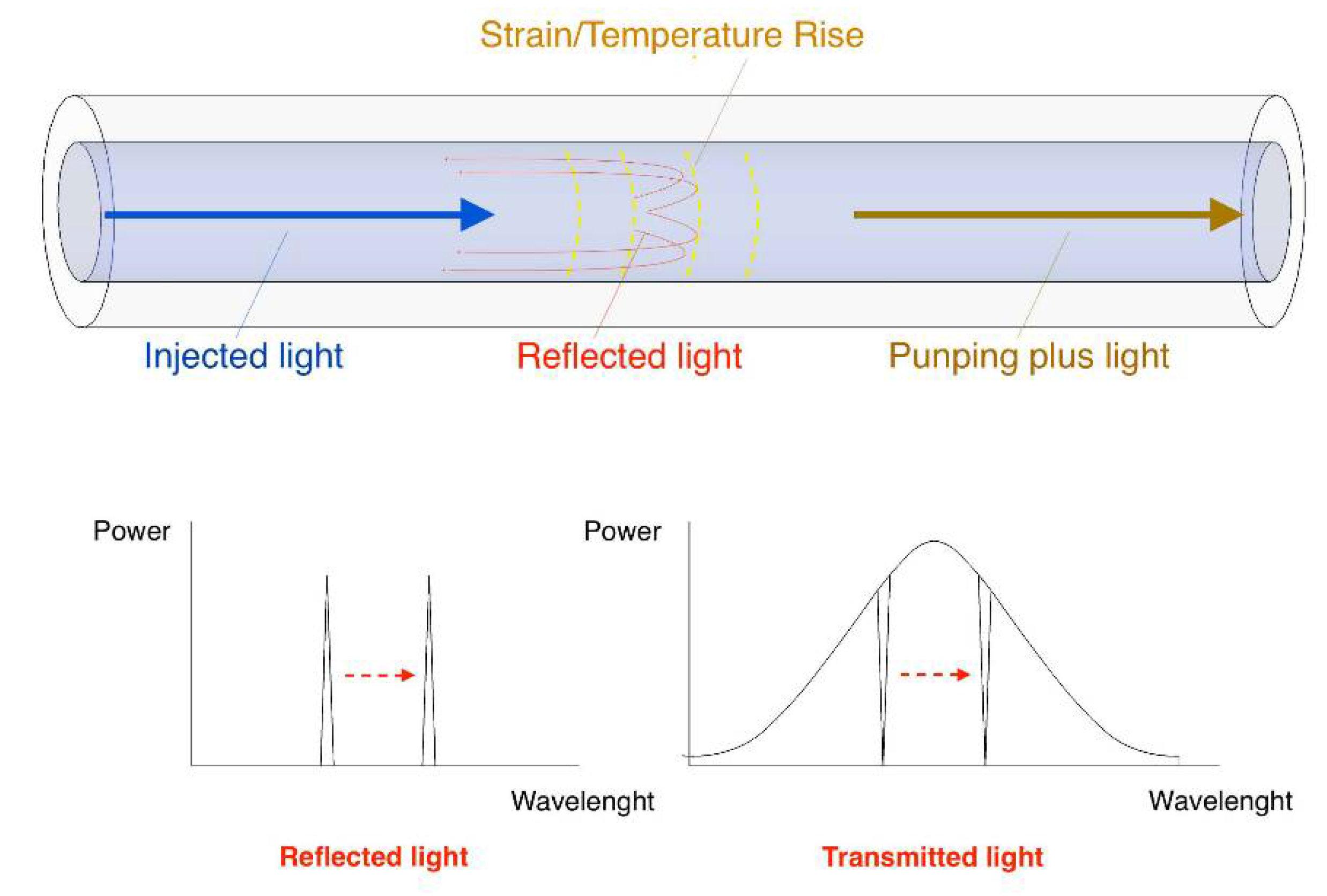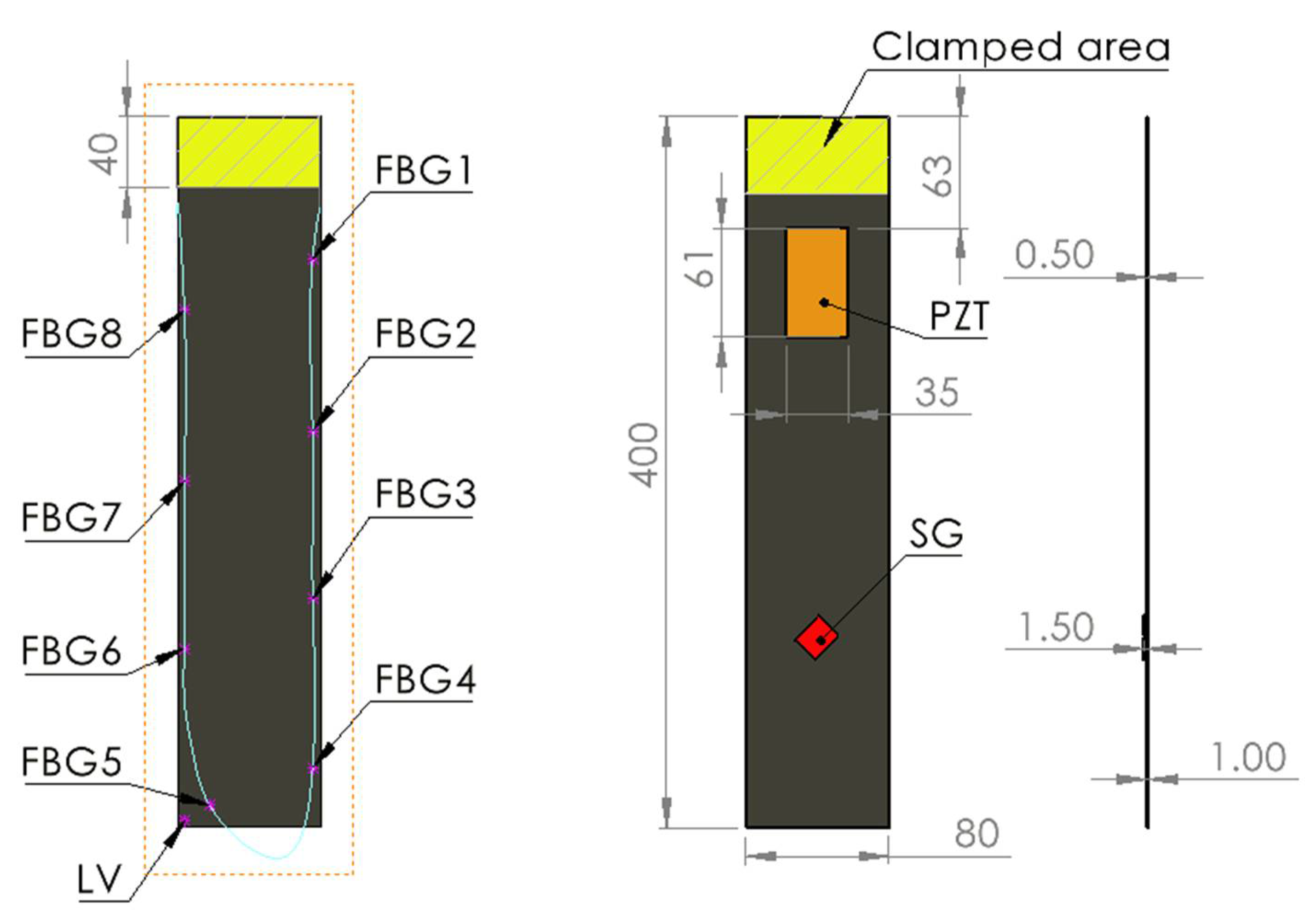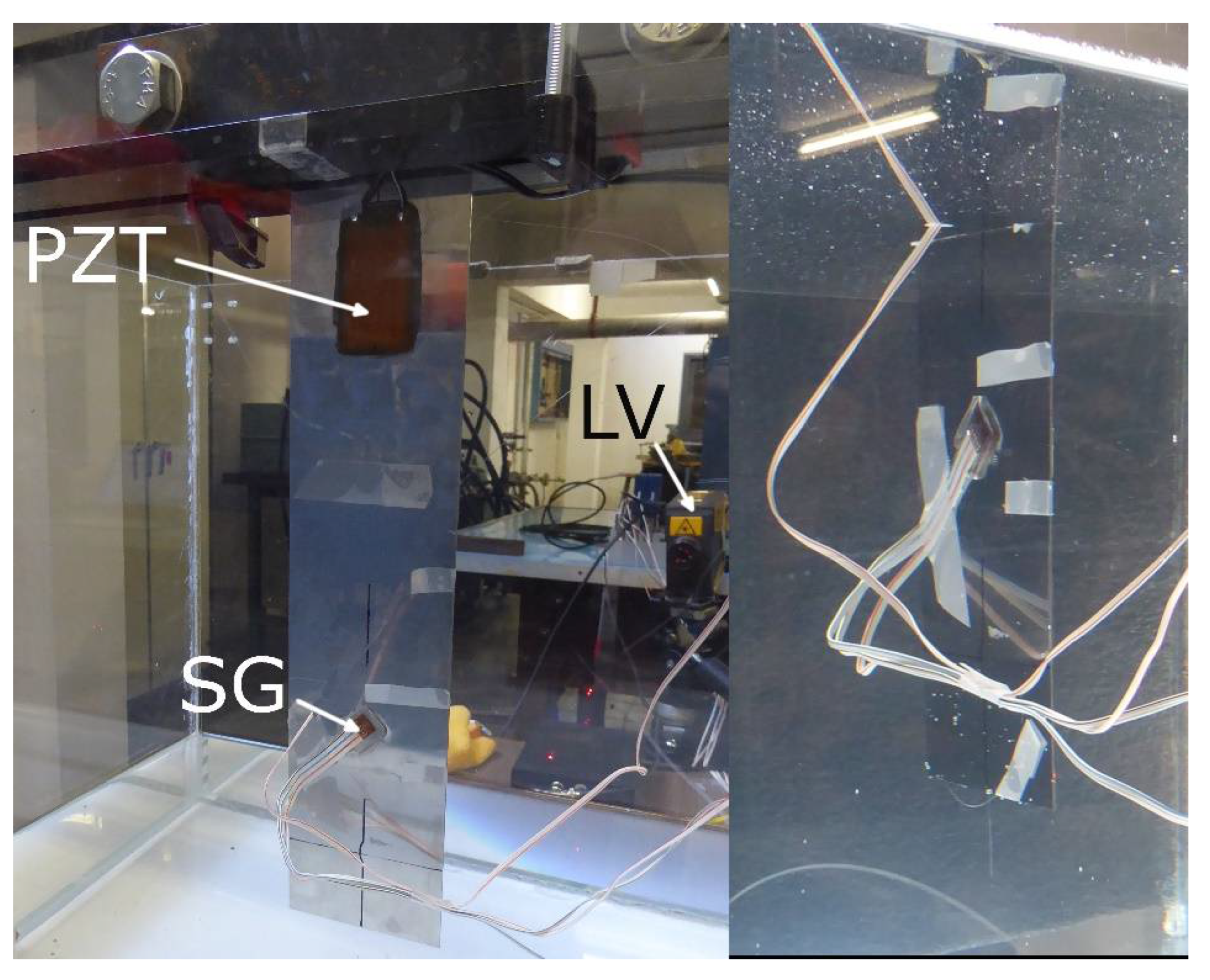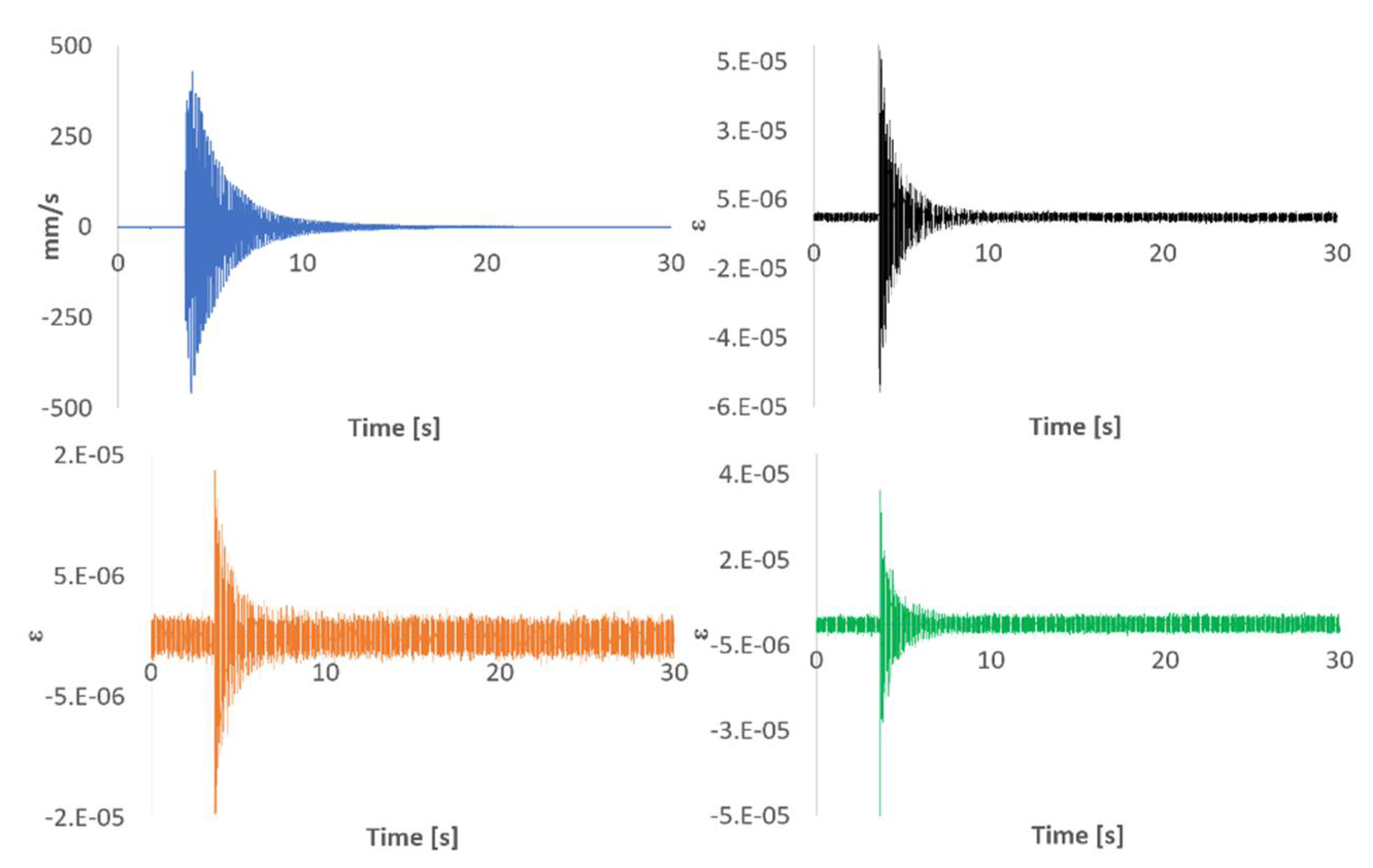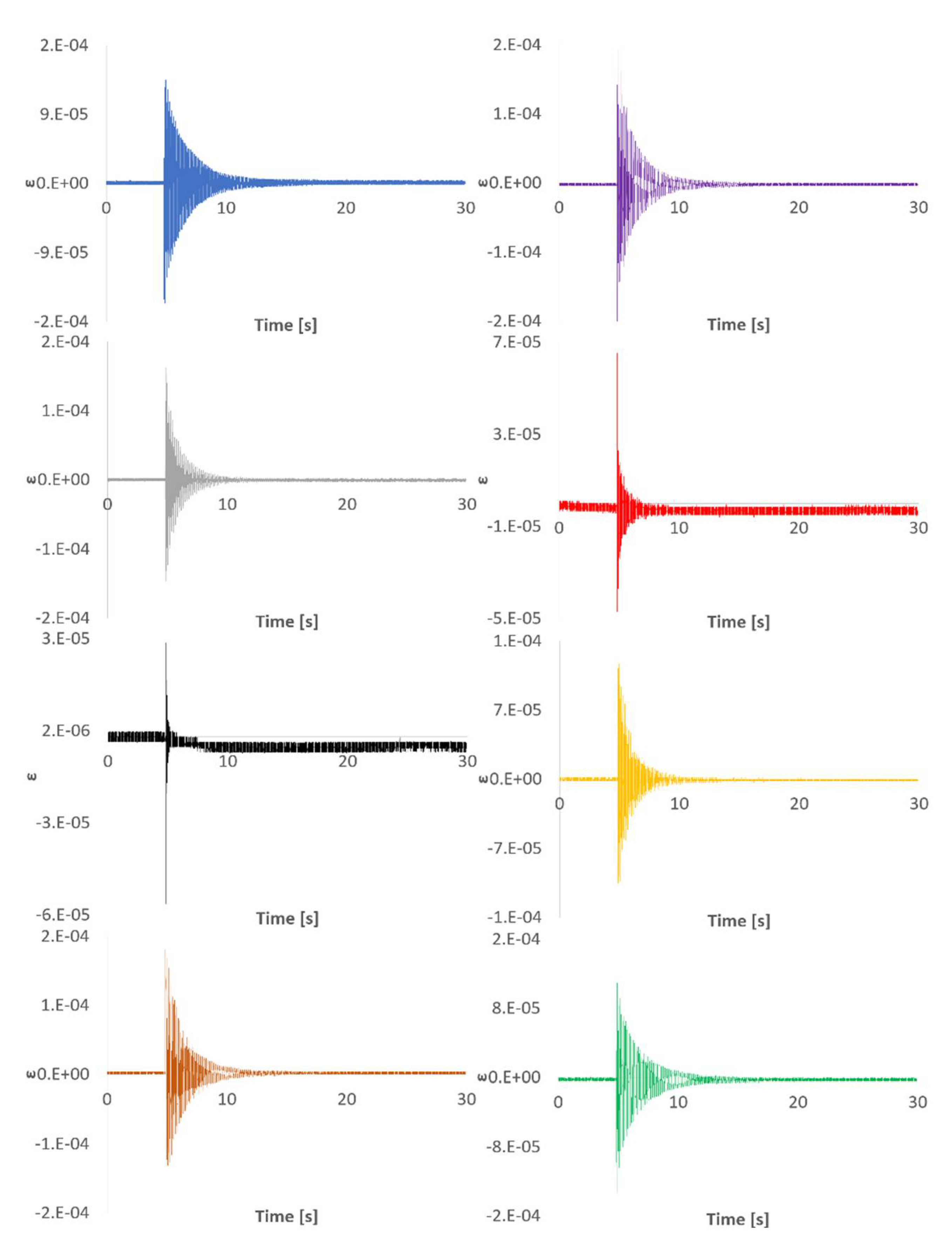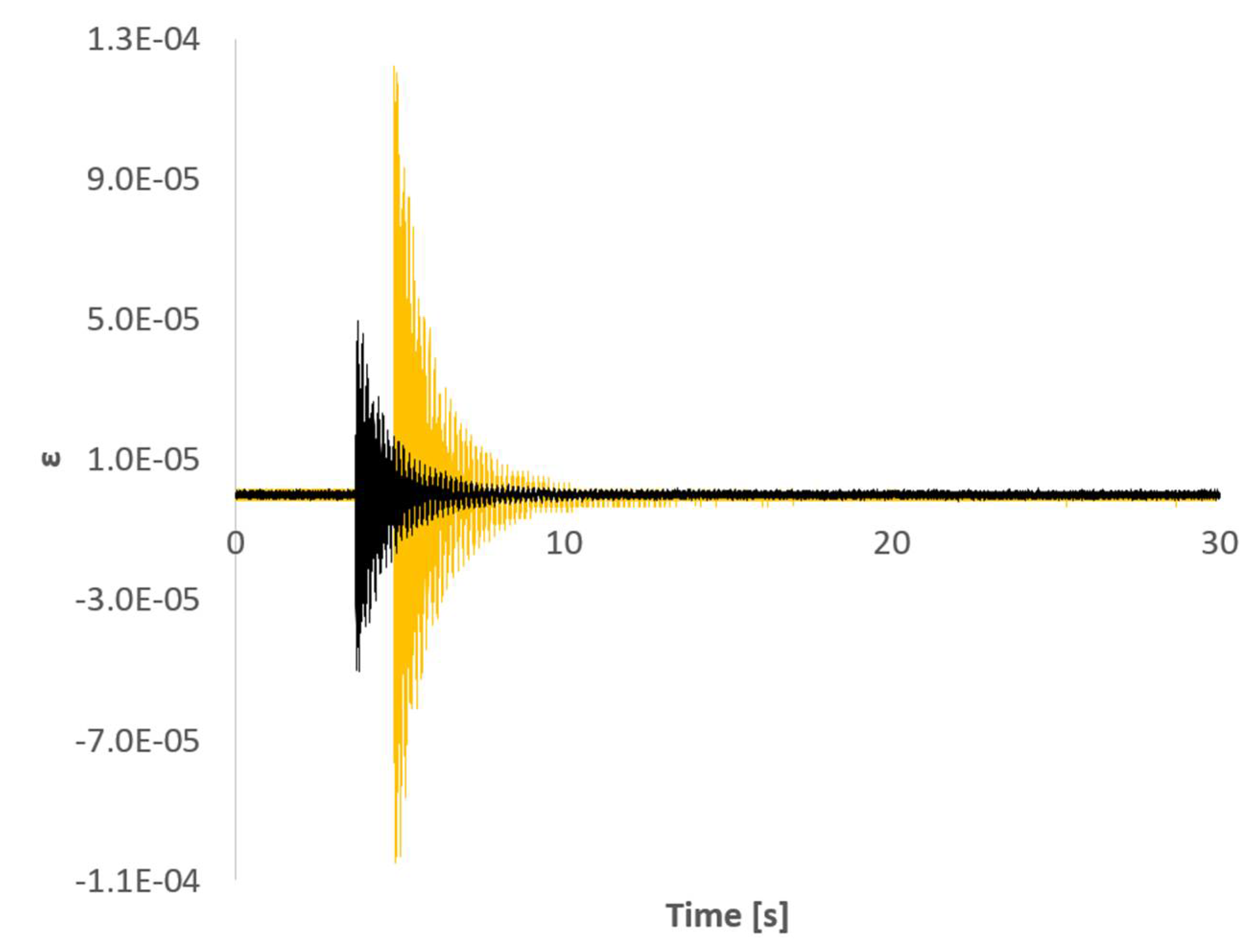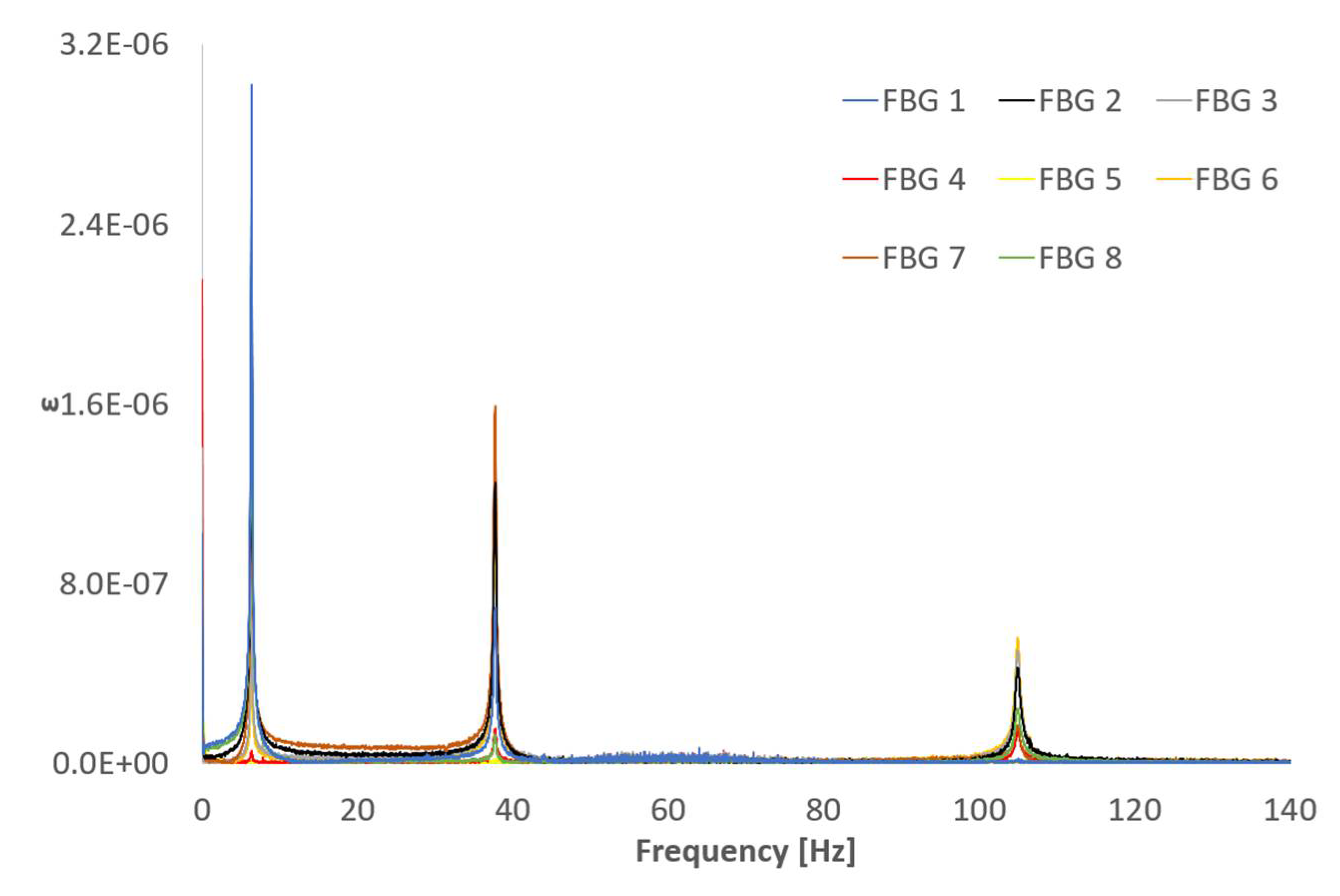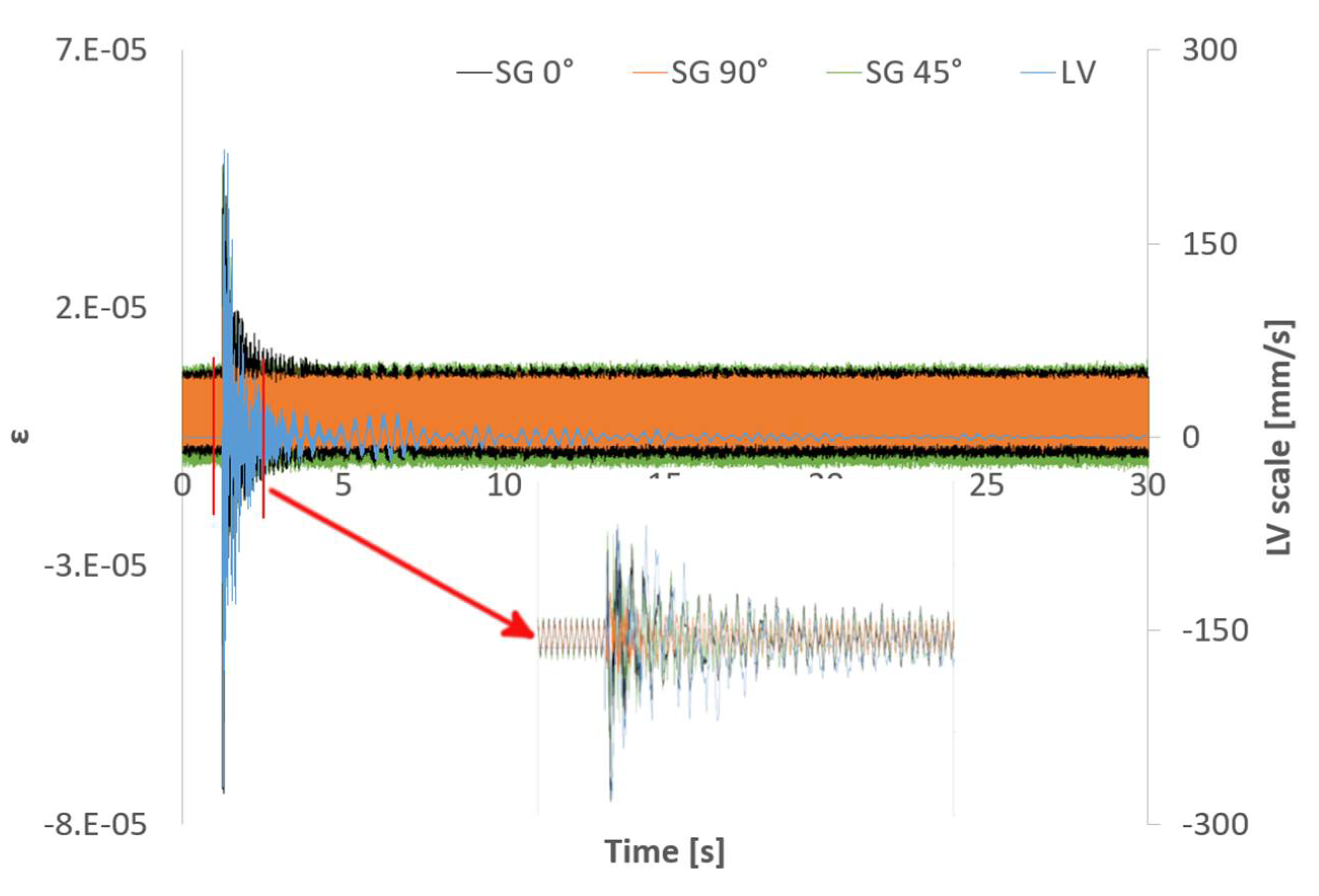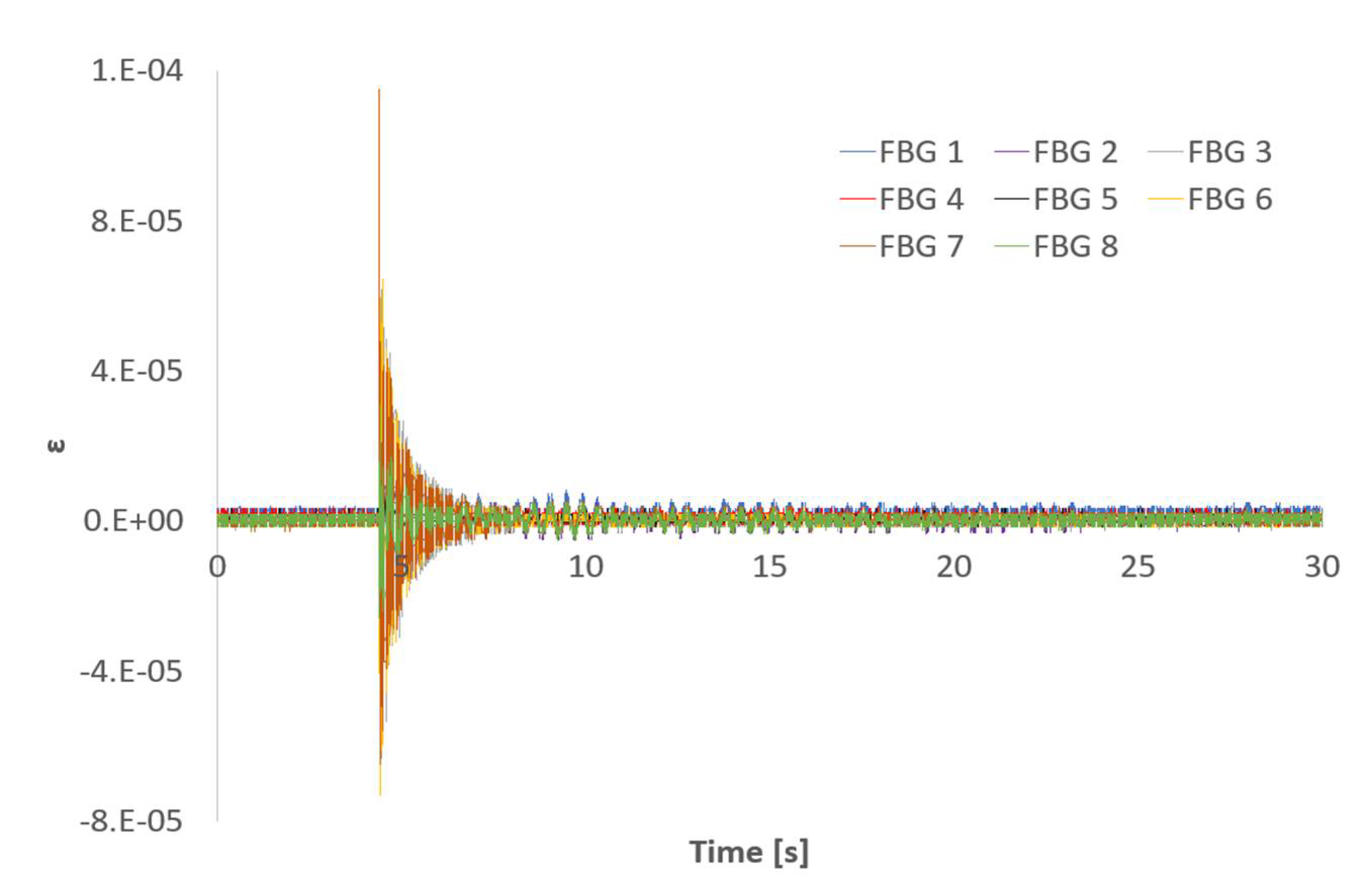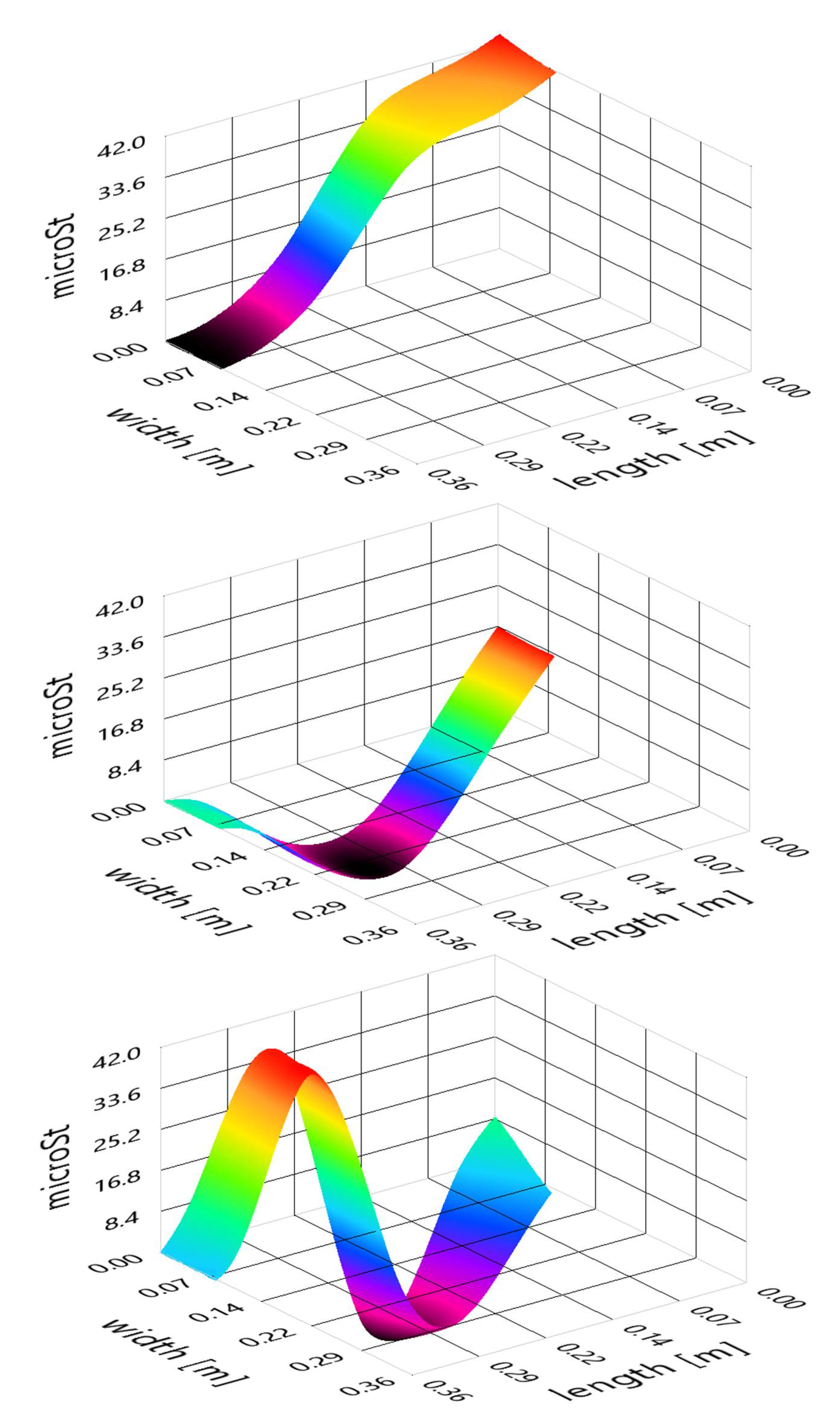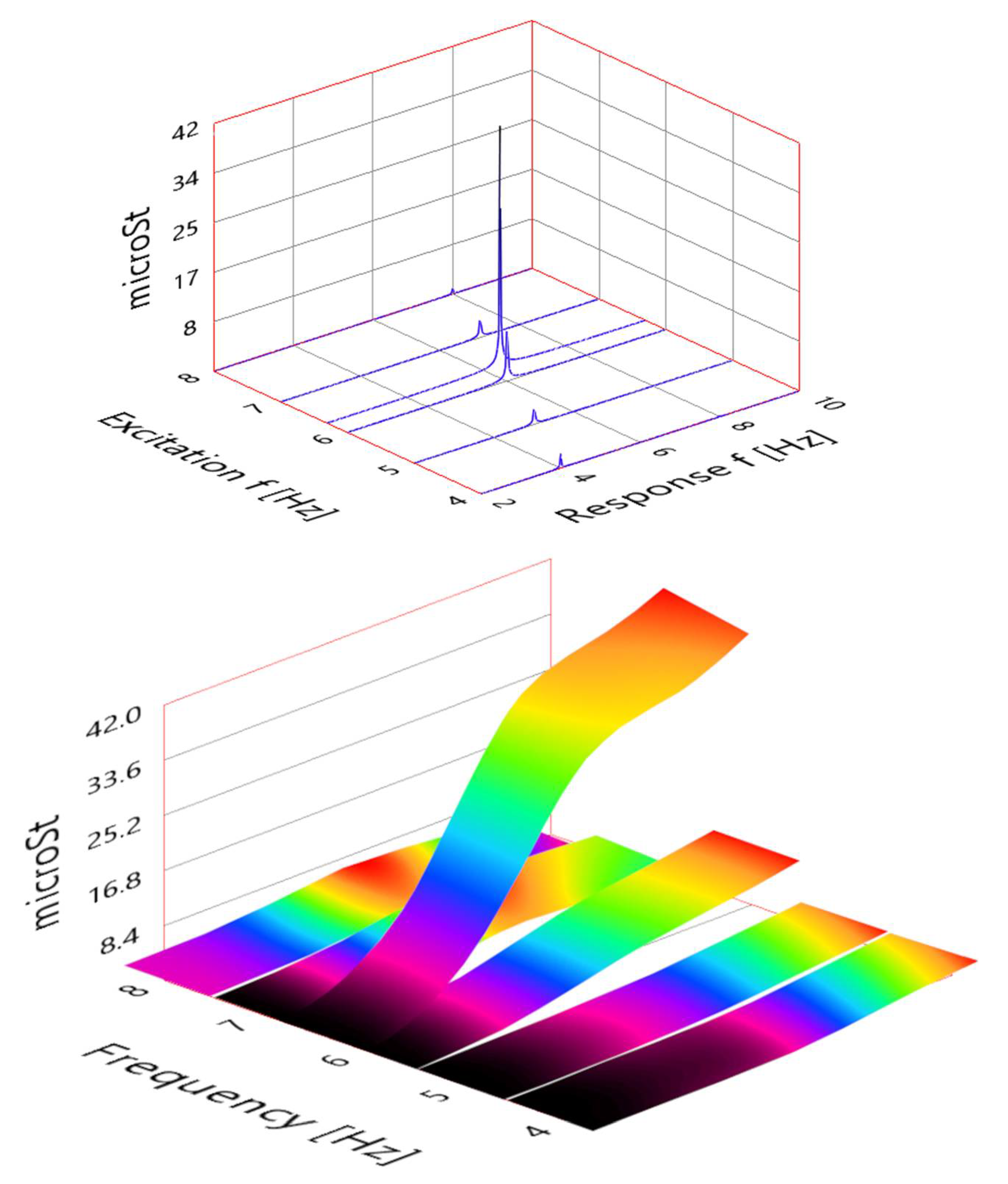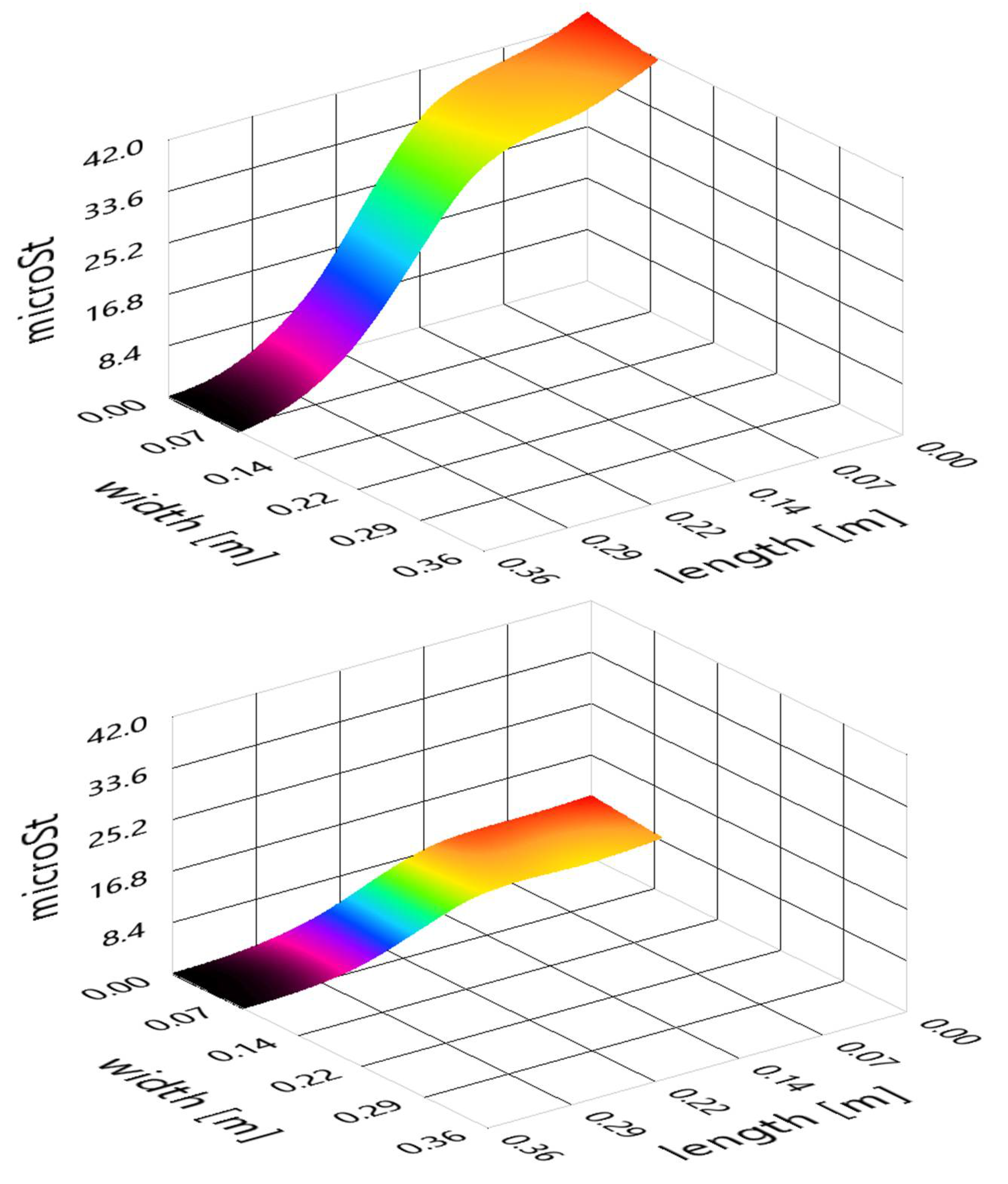Author Contributions
Conceptualization, O.d.l.T. and X.E.; methodology, O.d.l.T.; software, O.d.l.T.; investigation, O.d.l.T. and I.F.; validation, I.F., S.S., and X.E.; formal analysis, O.d.l.T.; resources, S.S. and X.E.; data curation, O.d.l.T.; writing—original draft preparation, O.d.l.T.; writing—review and editing, I.F., S.S., and X.E.; supervision, S.S. and X.E.; project administration, X.E.; funding acquisition, X.E. All authors have read and agreed to the published version of the manuscript.
Figure 1.
Sensing principle of fiber Bragg grating.
Figure 1.
Sensing principle of fiber Bragg grating.
Figure 2.
Front, back, and lateral view of the plate with the different sensing technologies used and the main dimensions in mm (FBG = fiber Bragg grating sensor, SG = strain gauge, PZT = piezoelectric patch, LV = laser vibrometer).
Figure 2.
Front, back, and lateral view of the plate with the different sensing technologies used and the main dimensions in mm (FBG = fiber Bragg grating sensor, SG = strain gauge, PZT = piezoelectric patch, LV = laser vibrometer).
Figure 3.
Cantilever beam above an empty (left) and a partially filled (right) plexiglass tank.
Figure 3.
Cantilever beam above an empty (left) and a partially filled (right) plexiglass tank.
Figure 4.
Impact time signal responses measured with LV (top left), SG 0º (top right), SG 90º (bottom left), and SG 45º (bottom right).
Figure 4.
Impact time signal responses measured with LV (top left), SG 0º (top right), SG 90º (bottom left), and SG 45º (bottom right).
Figure 5.
Impact time signal responses measured with FBG sensors: FBG 1 (blue), FBG 2 (purple), FBG 3 (grey), FBG 4 (red), FBG 5 (black), FBG 6 (yellow), FBG 7 (brown), and FBG 8 (green).
Figure 5.
Impact time signal responses measured with FBG sensors: FBG 1 (blue), FBG 2 (purple), FBG 3 (grey), FBG 4 (red), FBG 5 (black), FBG 6 (yellow), FBG 7 (brown), and FBG 8 (green).
Figure 6.
Time signal responses of SG 0º (black) and FBG6 (yellow).
Figure 6.
Time signal responses of SG 0º (black) and FBG6 (yellow).
Figure 7.
FFT of the SG and LV signals.
Figure 7.
FFT of the SG and LV signals.
Figure 8.
FFT of the FBG sensors signals.
Figure 8.
FFT of the FBG sensors signals.
Figure 9.
The beam´s first three bending modes with the location of the FBG sensors: displacement field (above), strain field (below).
Figure 9.
The beam´s first three bending modes with the location of the FBG sensors: displacement field (above), strain field (below).
Figure 10.
Time signals for an impact response for the SGs and the LV in partial submergence conditions. A zoomed view of the impact is also shown.
Figure 10.
Time signals for an impact response for the SGs and the LV in partial submergence conditions. A zoomed view of the impact is also shown.
Figure 11.
Time signals for an impact response for FBG sensors in partial submergence conditions.
Figure 11.
Time signals for an impact response for FBG sensors in partial submergence conditions.
Figure 12.
First bending peak comparison for: dry conditions (left), partially submerged (right).
Figure 12.
First bending peak comparison for: dry conditions (left), partially submerged (right).
Figure 13.
Beam´s experimental first three bending modes in air: first (top), second (middle), and third (bottom).
Figure 13.
Beam´s experimental first three bending modes in air: first (top), second (middle), and third (bottom).
Figure 14.
FBG 1 signal response (top) and beam mode shapes (bottom) for different frequency excitations.
Figure 14.
FBG 1 signal response (top) and beam mode shapes (bottom) for different frequency excitations.
Figure 15.
Beam first bending mode in air (top) and in water (bottom).
Figure 15.
Beam first bending mode in air (top) and in water (bottom).
Table 1.
value for the first three bending modes.
Table 1.
value for the first three bending modes.
| Nondimensional Modal Parameter | Value |
|---|
| 1.875104 |
| 4.694091 |
| 7.854757 |
Table 2.
Theoretical approximation for the three first bending frequencies.
Table 2.
Theoretical approximation for the three first bending frequencies.
| | f1 (Hz) | f2 (Hz) | f3 (Hz) |
|---|
| Theory | 6.23 | 39.06 | 109.36 |
Table 3.
Relative error of the experimental values with respect to the theoretical approximation.
Table 3.
Relative error of the experimental values with respect to the theoretical approximation.
| Sensor | Error1 (%) | Error2 (%) | Error3 (%) |
|---|
| LV | 1.83 | 3.44 | 4.00 |
| SG 0° | 1.97 | 3.37 | 4.00 |
| SG 90° | 1.83 | 3.46 | 4.09 |
| SG 45° | 1.83 | 3.47 | 4.04 |
| FBG 1 | 1.72 | 3.55 | --- |
| FBG 2 | 1.72 | 3.51 | 4.02 |
| FBG 3 | 1.72 | 3.51 | 4.03 |
| FBG 4 | 1.85 | 3.51 | 3.99 |
| FBG 5 | --- | --- | --- |
| FBG 6 | 1.72 | 3.55 | 4.02 |
| FBG 7 | 1.65 | 3.53 | 4.08 |
| FBG 8 | 1.72 | 3.62 | 3.99 |
Table 4.
Averaged damping factors and standard deviation for all sensors.
Table 4.
Averaged damping factors and standard deviation for all sensors.
| Sensor | | | |
|---|
| LV | 1.15 ± 0.09 | 0.39 ± 0.02 | 0.28 ± 0.01 |
| SG 0° | 1.03 ± 0.07 | 0.38 ± 0.02 | 0.27 ± 0.01 |
| SG 90° | 0.99 ± 0.08 | 0.37 ± 0.02 | 0.28 ± 0.01 |
| SG 45° | 1.02 ± 0.04 | 0.38 ± 0.02 | 0.27 ± 0.02 |
| FBG 1 | 1.03 ± 0.07 | 0.38 ± 0.01 | --- |
| FBG 2 | 1.02 ± 0.06 | 0.38 ± 0.02 | 0.27 ± 0.01 |
| FBG 3 | 0.99 ± 0.08 | 0.38 ± 0.02 | 0.27 ± 0.01 |
| FBG 4 | 1.23 ± 0.09 | 0.37 ± 0.01 | 0.28 ± 0.01 |
| FBG 5 | --- | --- | --- |
| FBG 6 | 1.00 ± 0.06 | 0.38 ± 0.02 | 0.27 ± 0.01 |
| FBG 7 | 0.95 ± 0.04 | 0.40 ± 0.00 | 0.27 ± 0.00 |
| FBG 8 | 1.03 ± 0.07 | 0.36 ± 0.03 | 0.27 ± 0.01 |
Table 5.
Theoretical approximation for the first three bending frequencies, partially considering added mass effect.
Table 5.
Theoretical approximation for the first three bending frequencies, partially considering added mass effect.
| | f1w (Hz) | f2w (Hz) | f3w (Hz) |
|---|
| Theory | 3.63 | 22.78 | 63.78 |
Table 6.
Experimental values for the first three bending frequencies in partial submergence conditions.
Table 6.
Experimental values for the first three bending frequencies in partial submergence conditions.
| Sensor | f1w (Hz) | f2w (Hz) | f3w (Hz) |
|---|
| LV | 2.51 | 21.14 | 73.88 |
| SG 0° | 2.51 | 21.14 | 73.89 |
| SG 90° | 2.51 | 21.12 | --- |
| SG 45° | 2.51 | 21.13 | 73.83 |
| FBG 1 | 2.50 | 21.13 | --- |
| FBG 2 | 2.50 | 21.11 | 73.93 |
| FBG 3 | 2.50 | 21.14 | 73.89 |
| FBG 4 | 2.50 | 21.12 | 73.87 |
| FBG 5 | --- | --- | --- |
| FBG 6 | 2.50 | 21.14 | 73.88 |
| FBG 7 | 2.50 | 21.11 | 73.81 |
| FBG 8 | 2.50 | 21.11 | --- |
Table 7.
Average damping rations and standard deviation for all sensors.
Table 7.
Average damping rations and standard deviation for all sensors.
| Sensor | | | |
|---|
| LV | 4.59 ± 1.36 | 0.77 ± 0.05 | 0.76 ± 0.14 |
| SG 0° | 4.32 ± 1.54 | 0.73 ± 0.03 | 0.64 ± 0.06 |
| SG 90° | 6.62 ± 3.01 | 0.73 ± 0.02 | --- |
| SG 45° | 3.66 ± 3.21 | 0.74 ± 0.05 | 0.63 ± 0.32 |
| FBG 1 | 2.60 ± 0.14 | 0.72 ± 0.04 | --- |
| FBG 2 | 3.27 ± 0.62 | 0.75 ± 0.05 | 0.45 ± 0.19 |
| FBG 3 | 3.82 ± 0.25 | 0.73 ± 0.03 | 0.55 ± 0.14 |
| FBG 4 | --- | 0.73 ± 0.03 | 0.68 |
| FBG 5 | --- | --- | --- |
| FBG 6 | 5.09 ± 3.46 | 0.69 ± 0.02 | 0.52 ± 0.11 |
| FBG 7 | 4.17 | 0.70 | 0.57 |
| FBG 8 | 2.65 ± 0.17 | 0.72 ± 0.06 | --- |
